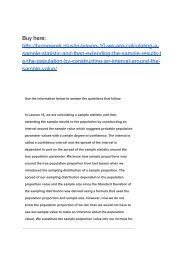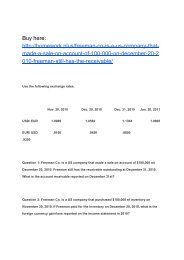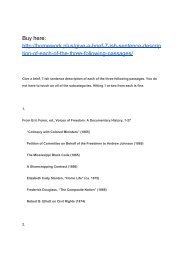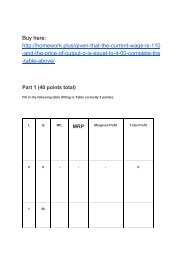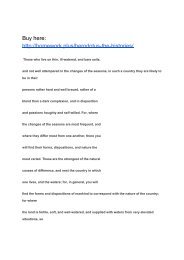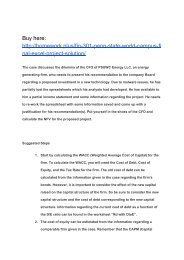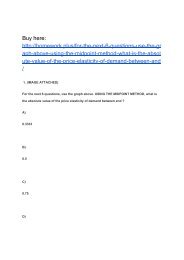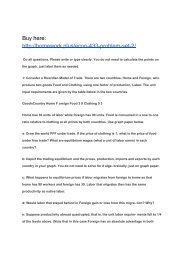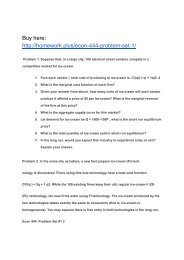CMPSC 200 MATLAB Lab 6
CMPSC 200 MATLAB Lab 6
CMPSC 200 MATLAB Lab 6
Create successful ePaper yourself
Turn your PDF publications into a flip-book with our unique Google optimized e-Paper software.
Buy here:<br />
http://homework.plus/cmpsc-<strong>200</strong>-matlab-lab-6/<br />
Instructions:<br />
<strong>CMPSC</strong> <strong>200</strong> Programming for Engineers with <strong>MATLAB</strong> <strong>Lab</strong> 6<br />
Create a single script (.m file) to solve this problem. Unless directed otherwise, use<br />
meaningful variable names for each variable; do not use the default variable ans to store<br />
your results. Suppress your output for every calculation or allocation with a semi-colon;<br />
you may only use print commands to print output.<br />
Please remember to follow the programming style sheet on ANGEL. When complete,<br />
please submit your code to the dropbox on ANGEL; the graders will run it to view your<br />
output. Name your file like this: username_lab6.m (example: bjs5332_lab6.m). Your<br />
submission must be a single .m file.<br />
Problem 1 (10 points)<br />
Permanent employees are generally classified under two different compensation<br />
schemes: wage payroll (“wage”) employees, and salaried employees. Wage employees<br />
receive an hourly rate for the time they work, and are eligible for overtime on the time they<br />
work over the specified “full- time hours”. Salaried employees receive a fixed paycheck<br />
regardless of the number of hours worked; as such, they are ineligible for overtime.<br />
Consider a company that compensates their wage employees as such:<br />
Full-Time Hours: 40<br />
Normal Hourly Rate: $23/hour
Overtime Multiplier: 1.5 (for time over 40 hours)<br />
Write a program that a payroll clerk could use to figure out the gross pay for their<br />
employees. Calculate the pay (printed only to 2 decimal places) for wage employees;<br />
include a notification if a wage employee will be receiving overtime pay. Since a salaried<br />
employee’s pay is fixed, there would be no reason to need to calculate it – a simple<br />
statement stating such to the user observing this fact will suffice. Prompt the user with a<br />
menu to choose “Wage Employee” or “Salaried Employee,” then use a switch to examine<br />
each of those cases as appropriate. Try to mirror the sample results I’ve included on the<br />
second page of this document.<br />
Emulate the behavior of a do while loop in <strong>MATLAB</strong> to ensure the program runs at least<br />
once; the program should run until the user enters a sentinel value of −1. Only enter<br />
numbers when you check if the program should terminate.<br />
Hints: (1) For wage employees, overtime only applies to the time worked over the full-time<br />
hours. (2) do while loops are unavailable in <strong>MATLAB</strong>, but we discussed how to emulate<br />
their behavior in Lecture 16 using while loops. (3) Only enter numbers to check if the loop<br />
should stop, otherwise the program will yield errors when you check the stopping criteria.<br />
(4) You might find it useful to nest an if statement into one of your switch cases.<br />
Sample Run I/O:<br />
How many hours did employee work?: 30<br />
Gross pay is $690.00<br />
Do you wish to continue?<br />
Enter -1 to terminate, otherwise the program will continue: 5<br />
How many hours did employee work?: 50
Employee will receive overtime<br />
Gross pay is $1265.00<br />
Do you wish to continue?<br />
Enter -1 to terminate, otherwise the program will continue: 2<br />
Salaried employees don't enter hours!<br />
Do you wish to continue?<br />
Enter -1 to terminate, otherwise the program will continue: -1<br />
Note: The selections on the menu needed to generate this output are: Wage Employee,<br />
Wage Employee, Salaried Employee





